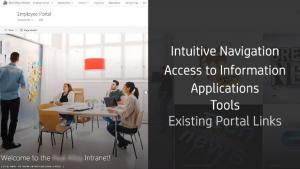Not to be confused with internet, the intranet is a closed communications network designed for internal use. Good intranets help keep your employees engaged and productive, so let’s take a look at SharePoint’s Intranet Portal, and what it can offer you!
Intranet Homepage
The Intranet Homepage is the first thing your employees see when they log in. So it stands to reason that a visually appealing page will increase both engagement and productivity.
With SharePoint Intranet, it’s easier than ever to build an intranet homepage that gives your users exactly what they need, be it news, a social feed, a countdown widget… You name it! And if you’d rather use something that’s already done, Microsoft has a set of Homepage prefabs you can take notes from.
News and Resources, for instance, uses the News carousel layout to give you large, scrollable images, along with webparts that show images, events, files, etc.
Social and Personalized uses a distributed news system, and focuses on a more social experience that shows, among other things, events and social conversations.
Compelling and Highly Visual is an attention-grabbing versatile option that uses the File Viewer and Embed web parts.
Hub Sites
SharePoint hub sites are sites in your organization that are connected to each other through certain attributes like project, region, or department. They help users discover content, and let them search across all associated sites rather than just the one. You can also apply common navigation, branding, and site structure en-masse—meaning, when you change something in a hub site, all connected sites will follow.
With SharePoint Intranet, Hubs are easy to create and maintain. They also come with examples you can use! For Marketing, the header, footer, and logo carry over to the other associated sites. Your Human Resources team can also have a hub where they can see news, contacts, resources—if you want, you can even add custom PowerApps for employee requests and talent acquisition, for instance. Sales is another example, where you can create a hub to connect regional sales teams and their sites.
Communication Sites
Another important feature in your intranet is Communication. With SharePoint, you can create communication sites solely for that purpose. You can broadcast a message to the company, share content, showcase serves, ask sections, or even connect a Yammer group your employees can use. All native to both web and mobile!
You can have a Communications site that’s Region Specific, for instance. You can also go more brand-driven, or have a site that’s all in a single page.
Team Sites
Last but not least, Team Sites are another attractive feature you can exploit. Team Sites in your Intranet are places where employees of a particular project or group can work together, plan events, exchange ideas, track the status of their progress, and so on. As a default, Team sites are also connected to an Office 365 group for a full range of communication and collaboration—including the use of Microsoft Teams and Planner.
You can use Team sites along with Hubs for consistent theme and design. You can make them more Project-Focused when you want to keep the attention on a specific project and its deadlines, or make like a Meet the Team page.
So how do I design my Intranet?
An Engaging SharePoint Intranet Portal will not just help your team, it will reduce paperwork, overhead, and keep them engaged. A well-designed one will make it even easier, not just on your eyes, but in terms of navigation as well.
It’s true you can take a look at Microsoft’s SharePoint Design Guidance and do it yourself. But you can also hire a team or company that specializes in creating Intranets, like ESW and its partner, Wizdom.
